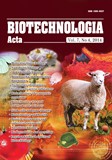ISSN 2410-7751 (Print)
ISSN 2410-776X (Online)

"Biotechnologia Acta" v. 7, no 4, 2014
https://doi.org/10.15407/biotech7.04.100
Р. 100-106, Bibliography 12, English.
Universal Decimal classification: 611-018.5.013.8:615.014.41
THE GENERATION OF REACTIVE OXYGEN SPECIES BY CORD BLOOD NUCLEATED CELLS DURING CRYOPRESERVATION
Ryazantsev V. V., Babijchuk L. A., Mykhailova O. O., Zubov P. M.
Institute for Problems of Cryobiology and Cryomedicine of the National Academy of Sciences of Ukraine, Kharkiv
The generation of reactive oxygen species in different populations of nucleated cells during cord blood cryopreservation was studied. Using cytometry with the 2′,7′-dichlorodihydrofluorescein diacetate dye we assessed the integral content of reactive oxygen species in various populations (lymphocytes, monocytes, granulocytes) of cord blood nucleated cells, depending on the method of isolation, treatment with cryoprotectant and freezing. Furthermore the activity of antioxidant enzymes prior to and after cryopreservation while the cells were loaded with exogenous reactive oxygen species, which source was hydrogen peroxide, was assessed. The results obtained showed that the isolation and cryopreservation of cord blood nucleated cells according to proposed method, which included the isolation of cells in polyglucinum and freezing with 5% DMSO did not result in a significant increase in level of intracellular reactive oxygen species. In addition the activity of antioxidant enzymes to exogenous hydrogen peroxide inactivation in cryopreserved cell was maintained at the level close to that in the native cord blood. Among all the populations of cord blood nucleated cells the granulocytes were the least resistant to cryopreservation effects.
Key words: nucleated cells, cord blood, cryopreservation, reactive oxygen species.
© Palladin Institute of Biochemistry of the National Academy of Sciences of Ukraine, 2014
References
1. Abdulkadyrov K. M., Romanenko N. A., Starkov N. N. Preparation and clinical application of peripheral hematopoietic stem cells from umbilical cord blood. Voprosy onkolohii. 2000, 46(5), 513–520. (In Russian).
2. Novickij V. V., Rjazanceva N. V., Chasovskih N. Ju., Starikova E. G., Kajgorodova E. V., Starikov Ju. V., Zhukova O. B. Modulation of apoptosis of mononuclear cells under conditions of oxidative stress. Biulleten eksperimentalnoi biolohii i mediciny. 2008, 145(3), 251–254. (In Russian).
3. Skulachev V. P. Phenomenon of programmed cell death. Mitochondria, cells and organs: the role of reactive oxygen species. Soros. obrazovat. zh. 2001, 7(6), 4–10. (In Russian).
4. Dubinina E. E. Role of reactive oxygen species as signaling molecules in the metabolism of tissues under conditions of oxidative stress. Voprosy medicinskoi khimii. 2001, V. 6, P. 561–581. (In Russian).
5. Gluckman E., Broxmeyer H. A., Auerbach A. D., Friedman H. S., Douglas G. W., Devergie A., Esperou H., Thierry D., Socie G., Lehn P., Cooper S., English D., Kurtzberg J., Bard J., Boyse E. A. Hematopoietic reconstitution in a patient with Fanconi’s anemia by means of umbilical-cord blood from an HLA-identical sibling. N. Engl. J. Med. 1989, 321(17), 1174–1178.
https://doi.org/10.1056/NEJM198910263211707
6. Babіichuk L. O., Grishhenko V. І., Gurіna T. M., Riazantsev V. V., Zubova O. L., Zubov P. M. Method of selection of cord blood nucleated cells. Ukraine. Patent 23499. 25.05.2007. (In Ukrainian).
7. Babіntsev V. V. Assessment of different populations state of cord and donor blood nucleated cells depending on the cryopreservation method. Problemy kriobiolohii i kriomeditsiny. 2011, 21(4), 385–394. (In Russian).
12. Melino G., Savini I., Guerrieri P., Finazzi-Agr? A. Redox buffering ability of lymphoid cells evaluated by the oxidation of 2?,7?-dichlorofluorescin. Free Radic Res Commun. 1990, 11(4–5), 213–221.

